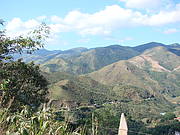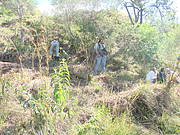Up the road from Rio - fresh forests and green jobs
Several centuries of farming have left the Atlantic rainforest north of Rio de Janeiro scarred and with just a few patches of forest left as havens to rare birds and mammals. Recovery of this forest would seem a tall order. But for Mauricio Ruiz, founder of Instituto Terra de Preservacao Ambiental (ITPA) this has been his life’s work.

View across what was once the Atantic Rainforest, just north of Rio de Janeiro

At age 15 he began ITPA with school friends, investing all his pocket money to start a tree-planting initiative. Now ITPA has 130 employees plus seasonal workers and has planted a host of trees across the state of Rio.
We visited one of ITPA’s projects in the dense Atlantic rainforest at Miguel Pereira, located inside the Tinguá Bocaina Corridor. Just north-west of Rio de Janeiro this area represents a significant portion of the Atlantic Forest or Mata Atlântica.
ITPA spokesperson, Aline Cavalcanti, explained what are the main challenges facing them in the region.
ITPA, created in 1998, works on conservation, reforestation and other environmental issues that concern the tropical rain forest on Brazil’s Atlantic coast. The main focus has been on the Tinguá Bocaina Corridor which includes important conservation hotspots for water and energy.
Guandu watershed is part of this area which supplies 80% of the water to metropolitan Rio and 30% of the city’s energy supplies. Within Miguel Pereira ITPA supports four reforestation projects employing local people in green jobs.
So just how successful has ITPA been in planting trees. Aline tells us more.
The Tinguá-Bocaina is so important because it is part of the Serra do Mar Biodiversity Corridor, which stretches over 18.5 million acres. The Brazilian Ministry of Environment and UNESCO see this as one of the most important priority areas for biodiversity in the Brazilian rain forest.
Source: International Union for Conservation of Nature
- 528 reads
Human Rights
Ringing FOWPAL’s Peace Bell for the World:Nobel Peace Prize Laureates’ Visions and Actions

Protecting the World’s Cultural Diversity for a Sustainable Future

The Peace Bell Resonates at the 27th Eurasian Economic Summit

Declaration of World Day of the Power of Hope Endorsed by People in 158 Nations

Puppet Show I International Friendship Day 2020

